... it all started in a chat room and IMHO is a chat acronym standing for: In My Humble Opinion. Maybe its not quite so 'humble' but these pages are where I get to spout off about all sorts of things and give the world the benefit of my amazing advice.
Saturday, July 22, 2006
Sweet Choice
'Intense sweeteners allow consumers to enjoy soft drinks while restricting their calorie intake if they wish to do so. They are always listed on the label so that consumers can have the choice'
How does this stand up to reality? In a visit to my local Tesco supermarket I was unable to find a single 2 litre bottle of lemonade which did NOT contain Aspartame. In each case the bottle was passed to me to read because my wife was unable to read the tiny print on the list of ingredients. (The one brand of lemonade which I know does not contain Aspartame, 7-up, was out of stock). Some choice! In the UK the matter has been made worse by the government, who introduced an extra tax on drinks containing a lot of sugar. manufacturers saw their demand for drinks fall and responded by using sweeteners instead of sugar. Stevia seems to be popular but since it leaves a liquorice like aftertaste they add other questionable things to disguise that.
Now I'm not saying Aspartame is bad - I just remain confused as to whether it is or is not safe so in the meantime I choose not to eat or drink the stuff.
Footnote Sept 28 2007
I'm pleased to find that Asda, Marks & Spencer and Sainsbury, for a while, stopped adding Aspartame to their own brand drinks. That means you can once again buy low cost lemonade without the stuff. Now maybe we can persuade Tesco to do the same?
Footnote April 2009
It seems that pandas are unique amongst animals in that they prefer the taste of Aspartame. In an experiment they, along with other animals were given a choice of water flavoured with six different natural sweeteners or six different artificial sweeteners. Only the pandas chose Aspartame - all the other animals (apart from cats, who can't taste sweetness) chose natural sweeteners. Hey - maybe that's why pandas are an endangered species? BBC news feature
Answer to Brain Teaser
Jane really said "I'm 2A (twenty A) today. Last year I was 29 (in hexadecimal numbers) and in two years time I'll be 2C (twenty C)"
If she's 2A in hexadecimal then that makes her 42 in the 'normal' decimal system.
Friday, July 21, 2006
ALL CAPS USER AGREEMENTS - Grr!
Why Why Why do software firms continue to write their 'terms and conditions' in ALL CAPS?
As a teacher one of the first things we were taught in college was not to write in capital letters only. The reason? It destroys the word shape and actually makes the text harder to read. When we read we look for word shapes and recognize the word without reading individual letters. Write the document in capitals and we have to recognize words by looking at individual letters. If we find a document written in capitals only we tend to give up and not bother reading it.
SpySweeper's terms and conditions is a typical example (although they do switch to mixed case after a paragraph or so). Who writes this drivel? Do they want us not to read it? I suspect it's probably a lawyer - a group of people who seem determined to make things as difficult as possible for the rest of us. Now Webroot - Explain this to your lawyers in nice simple language so that they can get it right next time - NOBODY WANTS TO READ ANY LONG DOCUMENT IF IT'S WRITTEN IN CAPITAL LETTERS ONLY AND PEOPLE WHO WRITE TITLES IN ALL CAPS RATHER THAN USING LARGER FONTS OR BOLD TEXT ARE JUST DISPLAYING TOTAL IGNORANCE OF GOOD DESIGN. THINGS HAVE MOVED ON SINCE THE DAYS OF TYPEWRITERS AND TO STICK WITH ALL CAPS ( OR EVEN WORSE UNDERLINED ALL CAPS) IS ABOUT THE SAME AS EMPLOYING A CLERK TO PAINSTAKINGLY COPY A DOCUMENT OUT BY HAND!
Sunday, July 09, 2006
Sugar and spice? - Err - Not quite
Acording to the nursary rhyme little girls are made of 'sugar and spice and all things nice' whereas little boys are made of 'slugs and snails and puppy dogs tails'. (Must have been a woman who wrote that one.) No matter how much little girls wish it the rhyme just isn't true.
So what exactly are we made of? Let's take a look at Mr Average: 38 years old, 5' 9" and weighing 79.83 Kg (179 lb)
61% of Mr Average is oxygen. It weighs 49 Kg (107lb) and as a gas it would occupy a volume of 34,000 litres (1,200 cubic feet) That's enough to keep an average person breathing for 68 days. Most of the oxygen is found in the water which makes up 55% of the bodies mass.
23% of Mr Average is carbon. It weighs 18.24 Kg (40lb). Thats about 6 bags if you want to have a BBQ.
10% of Mr Average is hydrogen. It weighs 7.98 Kg (17.6lb) and as a gas would take up 89,400 litres (3,160 cubic feet). In a balloon it would be capable of lifting 220 lb.
2.6% of Mr Average is nitrogen, mostly in the proteins of his body. It weighs 2.08 Kg (4.6lb) and would make enough fertilizer to cover 1/5th of an acre
1.4% of Mr Average is calcium. That's 1.12Kg (2.5lb). It's found in bones and teeth, is important for membrane function, nerve impulses, muscle contractions, and blood clotting. Converted to plaster it would be enough to cover 3 square feet of wall.
1.1% of Mr Average is phosphorus, 878g (1.931b). It's found in bones and teeth, nucleic acids and is important in providing you with energy. It's enough to make about 500 boxes of matches.
0.2% of Mr Average is potassium, 160g (5.6oz). It's important for proper membrane function, nerve impulses, and muscle contractions. Since potassium perchlorate is also used in making matches there's enough in Mr Average to make 160 boxes.
0.2% of Mr Average is Sulphur, 160g (5.6oz). Its found in fats, bones and proteins. there's enough sulphur in Mr Average to make the sulphuric acid for 50 car batteries.
0.14% of Mr Average is sodium, 112g (4oz). It's mostly in body fluids. Thats enough to make salt to put on about 1000 bags of fries.
0.12% of Mr Average is chlorine, 96g. (3.4oz) It's important for membrane function and water absorption. The chloride ion is the major anion in body fluids and it's essential in digesting food. There's enough to make several bottles of bleach or as pure chlorine gas it would occupy a volume of 30 litres - enough to kill Mr Average several times.
0.027% of Mr Average is magnesium, 21.6g: It's needed in enzymes, for bone formation and in using energy. Converted into antacid tablets you'd get 120.
0.006% of Mr Average is iron, almost 5g (0.1oz) It's needed in the blood to transport oxygen. There's enough in Mr Average to make a 2½ inch nail.
0.0037% of Mr Average is fluorine, 3g. Thats enough to make 660 tubes of fluoride toothpaste and again more than enough to kill Mr Average if taken all in one go.
0.0033% of Mr Average is zinc, 2.6g. It's found in enzymes. There's enough zinc in Mr Average to galvanize 74 square centimetres of steel on both sides.
0.0014% of Mr Average is silicon, 1.1g. It appears to help bones absorb calcium. That amount of silicon is found in ½ teaspoon of sand.
Rubidium and Strontium together make up about 1g of Mr Average. Rubidium seems to help the body select between sodium and potassium ions and strontium helps in the formation of bones. There's not enough of either to colour a firework.
There's about .3g of bromine (about 1 drop) in Mr Average. No-one is quite sure what it's function is.
There's about 0.1g of lead in Mr Average. In the past this was thought to be of no use and only harmful. Today a trace amount is believed to be necessary. That amount is enough to make one piece of birdshot.
Mr Average contains 0.08g of copper. Its used to make hemoglobin (in blood) and melanin (what colours your hair and suntan). That amount of copper could fit in a cube 2mm (1/13th inch) square.
There's enough aluminium in Mr Average, 0.07g, to make a piece of thick kitchen foil 7cm (2¾ inches) square. A tiny amount is needed in our bodies as a catalyst.
There's 0.06g of cadmium in Mr Average. It's found in some enzymes. Too much will kill painfully. It would take 75 Mr Averages to make just 1 AA size rechargable battery. (OK this was written in the days of NiCad rechargable batteries)
The remaining elements in Mr Average are in vanishingly small quantities. So here they are in a table.
| Element | % | Weight (g) | Comment |
| cerium | 0.000057% | 0.046 | Today it's used in making flat screen TVs, formally one of its main uses was in making mischmetal alloy which was used as the flint in cigarette lighters. There's enough in Mr Average to make one flint. |
| barium | 0.000031% | 0.025 | Barium is an ingredient in rat poison, the mud used in oil drilling and as a milky liquid 'Barium meal' used in x-rays of the intestines, There's not enough of it in Mr Average to kill a rat. |
| iodine | 0.000029% | 0.023 | Enough to make 3500 cuts sting! |
| tin | 0.000029% | 0.023 | Enough to tin plate a tomato puree can |
| titanium | 0.000029% | 0.023 | Titanium is a light but very strong metal, still strong at high temperatures. It's used in aircraft and jet engines. It also makes the filament in vaping tubes. There's enough in Mr Average to make several. |
| boron | 0.000026% | 0.021 | , |
| nickel | 0.000021% | 0.017 | You would need about 75 Mr Averages to make a US nickel |
| selenium | 0.000021% | 0.017 | , |
| chromium | 0.00002% | 0.016 | , |
| manganese | 0.000017% | 0.014 | , |
| arsenic | 0.00001% | 0.008 | , |
| lithium | 0.00001% | 0.008 | , |
| cesium | 0.0000086% | 0.0068 | , |
| mercury | 0.0000086% | 0.0068 | About as big an amount as the head of a pin |
| germanium | 0.0000071% | 0.0057 | , |
| molybdenum | 0.0000071% | 0.0057 | Enough to make a small light bulb (or at least the wires that hold the filament in place) |
| cobalt | 0.0000043% | 0.0034 | , |
| antimony | 0.0000029% | 0.0023 | , |
| silver | 0.0000029% | 0.0023 | , |
| niobium | 0.0000021% | 0.0017 | , |
| zirconium | 0.0000014% | 0.0011 | , |
| lanthanium | 0.0000011% | 0.00091 | , |
| gallium | 0.000001% | 0.0008 | , |
| tellurium | 0.000001% | 0.0008 | , |
| yttrium | 0.00000086% | 0.00068 | , |
| bismuth | 0.00000071% | 0.00057 | , |
| thallium | 0.00000071% | 0.00057 | , |
| indium | 0.00000057% | 0.00046 | , |
| gold | 0.00000029% | 0.00023 | Enough to make one tiny gold chain link worth 0.6¢ |
| scandium | 0.00000029% | 0.00023 | , |
| tantalum | 0.00000029% | 0.00023 | , |
| vanadium | 0.00000016% | 0.00013 | , |
| thorium | 0.00000014% | 0.00011 | , |
| uranium | 0.00000014% | 0.00011 | , |
| samarium | 0.00000007% | 0.000057 | , |
| beryllium | 0.00000005% | 0.000041 | , |
| tungsten | 0.00000003% | 0.000023 | , |
Friday, July 07, 2006
The Last Supper
- A Study of the Painting by Leonardo Da Vinci
The Last Supper is a painting painted between 1496 to 1498 by Leonardo Da Vinci in the refectory of the Dominican convent of Santa Maria delle Grazie. The painting was made using experimental pigments directly on the dry plaster wall and unlike frescos, where the pigments are mixed with the wet plaster, it has not stood the test of time well. Even before it was finished there were problems with the paint flaking from the wall and Leonardo had to repair it. Over the years it has crumbled, been vandalized bombed and restored. Today we are probably looking at very little of the original.
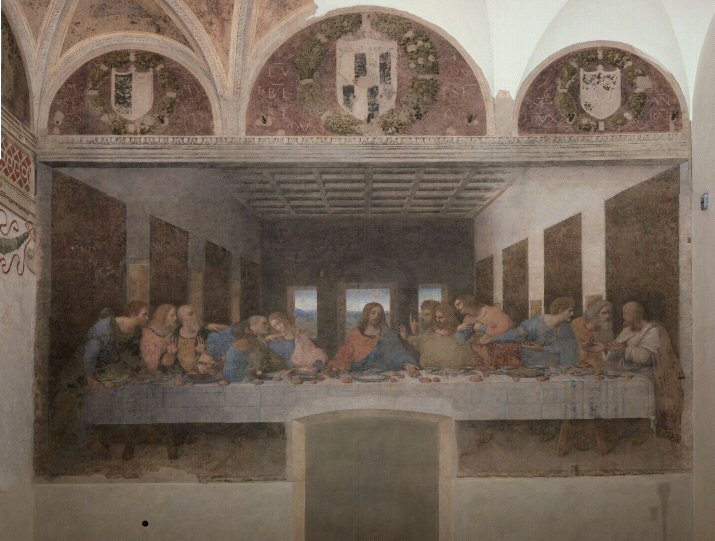
There are a number of points of interest:
Was it a 'Passover'?
Definitely not! The meal was set the day before 'Good Friday' - the day Jesus was crucified. The feast of the Passover began at sunset on that day so this meal was a day too early and, looking out the windows in the background, too early in the day. Also the picture shows Jesus and the disciples seated. The passover is traditionally eaten reclining. If you read your bible you will find:Matthew 26.2 "You know that after two days the Passover is coming, and the Son of man will be delivered up to be crucified." 26.3 Then the chief priests and the elders of the people gathered in the palace of the high priest, who was called Ca'iaphas, 26.4 and took counsel together in order to arrest Jesus by stealth and kill him. 26.5 But they said, "Not during the feast, lest there be a tumult among the people."
John 13.1 Now before the feast of the Passover, when Jesus knew that his hour had come to depart out of this world to...
The food
The table shows leavened bread (yet another reason it could not be the Passover), fish, wine and some type of herb present. To me there also appears to be cheese present. There is no sign of lamb which would traditionally have been eaten at the passover.The Cups/Glasses/Wine/Plates
There are twelve glasses shown to be present, each containing a red wine. It would be normal to drink wine with the meal - water was often contaminated. The glasses were odd however. Glass was popular with the Romans of the time but the conservative Jews would have drunk from goblets made from clay or wood. Only the wealthy would have drunk from metal goblets. The same is true of metal plates, several of which are shown. There's no pitcher or jug shown from which the glasses could have been refilled. There is a small, apparently empty, glass bottle, but this is too small to have contained the wine needed.The instant depicted
This is supposed to be the moment when Jesus, in the words of John says "Truly, truly, I say to you, one of you will betray me". The picture shows the reaction of the disciples to this.What's that bit centre bottom?
Around 1652, some unknown vandal decided to insert another door into the refectory and apparently decided that the only logical spot for it was smack in the middle of that wall where Leonardo had painted Christ's feet. The only evidence we have of what the original painting looked like was an oil paint copy made in the 16th centaury and now housed in Tongerlo Abbey , Antwerp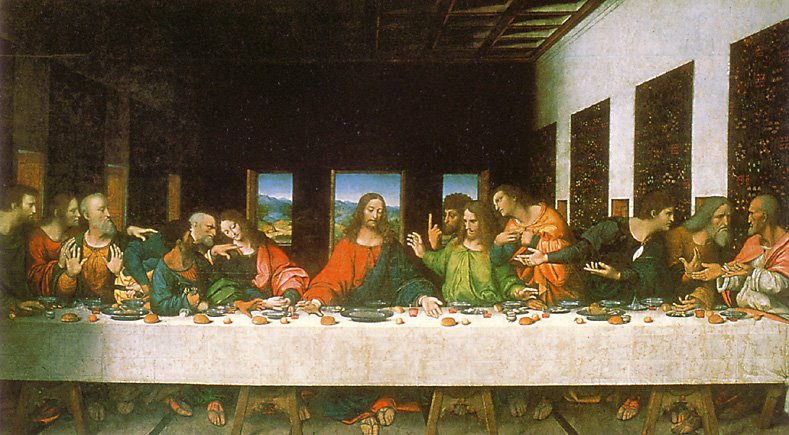
Just to complicate matters there's also a different version of the picture in a tapestry shown below:

The Knife
the owner of the hand holding the knife (or, as some call it, - a dagger):
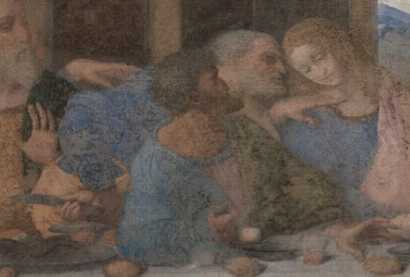
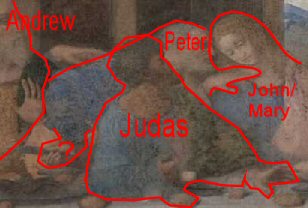
The theories are:
- The hand belongs to John/Mary (whoever you choose to believe they are). Peter is holding his/her wrist. Andrew, who sees this, is horrified at this.
- The hand belongs to a separate, obscured person, probably John, with Mary shown at the right.
- The hand holding the knife belongs to Peter - he has it twisted backwards away from Judas
- Here's an image which has been doctored to remove Judas. Notice anything odd?
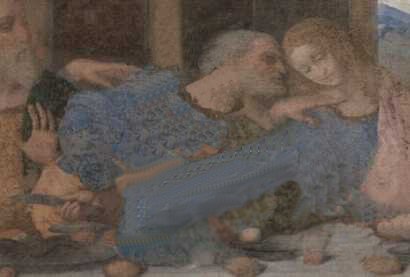
If that knife is being held by John/Mary then he/she has arms like a gorilla! Would Leonardo have made a mistake like this? There's also the evidence of John/Mary's fingers intertwined in front of him/her!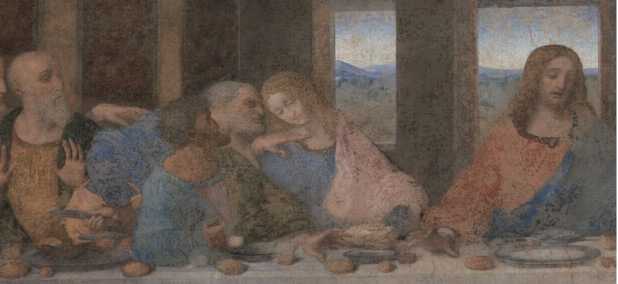
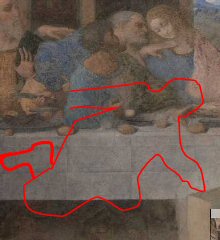 This suggestion assumes that the feminine figure at the right in the image is Mary Magdalene. In that case John, the youngest of the disciples is missing. The idea is that the hand belongs to John who is obscured by Peter and
This suggestion assumes that the feminine figure at the right in the image is Mary Magdalene. In that case John, the youngest of the disciples is missing. The idea is that the hand belongs to John who is obscured by Peter and
Judas. I find this very unlikely. If it were true - where exactly would John be?
Maybe he dropped his glass?
 The last suggestion is that Peter is holding the knife at a very odd angle. The 'copies' suggest that this is the case and so too does this sketch by Leonardo - clearly that knife in the hand of Peter gave him some problems and he decided to practice.
The last suggestion is that Peter is holding the knife at a very odd angle. The 'copies' suggest that this is the case and so too does this sketch by Leonardo - clearly that knife in the hand of Peter gave him some problems and he decided to practice.
John or Mary Magdalene?
In the fictional book 'The Da Vinci Code', Daniel Brown has his character Teabing suggest that the figure seated to Jesus' right is not the disciple John but is instead Mary Magdalene. The theory, suggested several times in the past, is that Jesus married Mary and after the crucifixion she had a child by him.I must admit that to my eye 'John' does look very effeminate. But is that enough evidence for the figure being Mary? We need to consider the following:
- Would the Church of the time have allowed this?
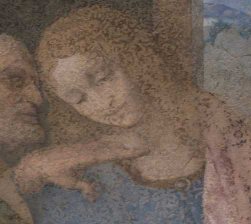
- It was 'normal' at the time for a young man, and John was the youngest of the disciples, to be portrayed
as effeminate. Not only Leonardo did this. - Leonardo is suspected to have been a homosexual.
- If 'John' is 'Mary' then where is John? Hiding under the table?
- Is that a necklace around 'John's' neck? If so - whatever happened to 'go, sell what you possess and give to the poor'. However no fewer than six others in the painting have a similar item, possibly a garment fastener.
- In 'The Da Vinci Code' Teabing refers to 'delicate folded hands, and the hint of a bosom'. Sorry - I don't see either! John's hands don't look feminine and to see a 'bosom' you need a great deal of imagination.
Who is where in the picture?

The evidence for this comes from a contemporary document discovered in 1800 which gives the names of each person in the picture.
The grouping
Looking across the picture from left to right the disciples are shown in four groups of three:- Bartholomew, James Minor and Andrew form a group of three. All are horrified, Andrew to the point of holding his hands up in a "let's calm down " gesture.
- Judas, Peter and John form the next group of three. Judas has his face in shadow and
is clutching a small bag, presumably money. He was quite often portrayed with this in last supper paintings. He is also reaching for bread at the same time as Jesus is. Peter, in the fashion of the time, is shown clutching a knife and, with his hand on John's shoulder, is asking a feminine-looking John "Who does he say it is?". John leans toward him to hear what he says creating a V shape between himself and Jesus which has been interpreted by some as an indication of a marriage between 'Mary' and Jesus. - Christ is very much the calm person alone in the midst of the debate.
- Thomas, James the Elder and Philip are next. 'Doubting' Thomas is pointing upward, maybe asking for one shred of evidence that this is so. His other hand is on the table between James and Philip as though seeking something solid. James the Elder looks stunned and seems to be watching Jesus' left hand. Philip seems to be asking 'Is it me?'.
- Matthew, Thaddeus and Simon comprise the last group of three figures. Matthew and Thaddeus seem to be asking Simon about Jesus' statement.
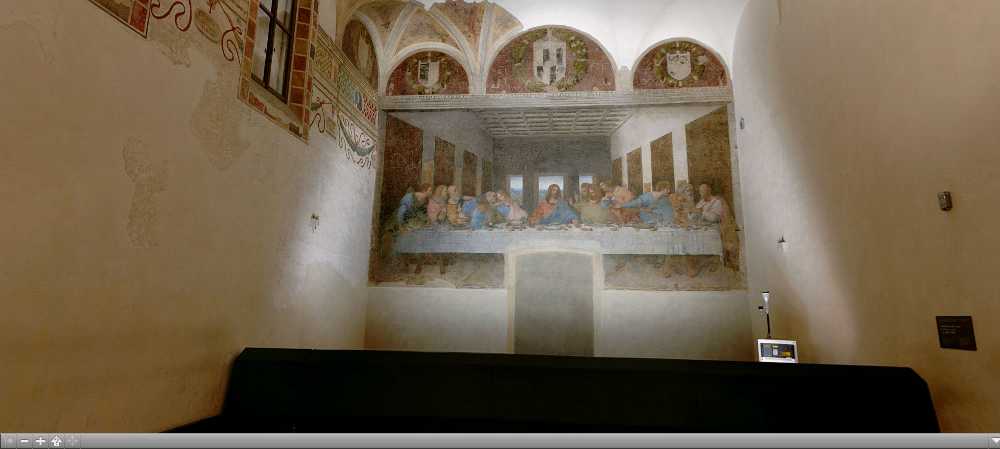
by written by Lynn Picknett and Clive Prince in 1997. 750 refer to an even earlier book Holy Blood, Holy Grail by Michael Baigent, Richard Leigh and Henry Lincoln (Even Daniel Brown refers to this book within his story and the character 'Leigh Teabing' seems to be a combination of 'Richard Leigh' and an anagram of 'Baigent')
About Commenting
I've rejected a number of comments from people for or against religion. This isn't the place for that. it's about the painting and the various theories which have arisen from it.Thursday, July 06, 2006
AntiPhishing in Internet Explorer Beta 2 - Grrr!
It seems that Microsoft, in it's wisdom, has decided that us lesser mortals will be confused by the presence of a new folder in our temporary Internet files so decided to hide it. Not content with making it 'hidden' or a 'protected system' file, they created a new file type normally not visible to users in the same way as rootkits hide their files. SpySweeper, one of the programs I use to get rid of malware found it and told me the pathname. Knowing this I can enter it into a folder address bar and display the contents - it's:
C:\Documents and Settings\[username]\Local Settings\Temporary Internet Files\AntiPhishing (Where [username] is what you log on as)
The hidden folder appears to contain a single file (yes - I suppose they could have more hidden files in there). Investigating this file, it appears to contain the URL to which IE7 refers web addresses to check if they are genuine. You can't navigate to this folder the 'normal' way and deleting it is not possible the normal way either.
Now I think a browser that checks to see if that 'Barclays bank' link is genuine is a great idea. But super hiding the AntiPhishing folder is an idea that sucks! I want - no demand - to be able to investigate EVERY file on my computer. Someone who 'hides' a file makes me very suspicious. What if someone makes use of that hidden folder to 'hide' their malware?
Wonder what else Microsoft has hidden?
As to the rest of IE7? Nice one MS. Apart from that hidden folder - I like it.